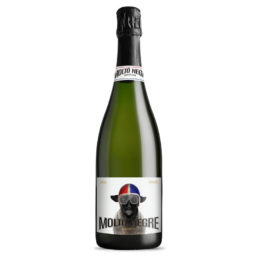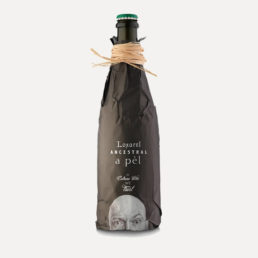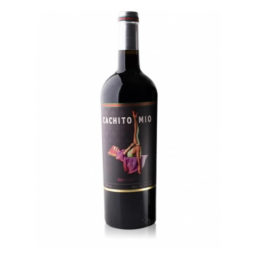post
Showing all 18 resultsSorted by latest
-
Marqués de Riscal Rosé Wine
Marqués de Riscal begins the production of rosé wines in the years 60, coinciding with the centenary of the winery, made from grapes from young vines, less than 15 years old. This rosé is made by the pressing procedure within a concept of classicism and refinement, achieving a delicacy, freshness and softness unusual in this type of wine. Fermentation takes place in stainless steel tanks at a controlled temperature between 14ºC and 16ºC to achieve great fruitiness.Grape variety:Grenache 85%Viura 10%Malvasia 5%degree: 14º -
Marqués de Cáceres White Wine
Marqués de Cáceres is a leader in the production and marketing of Rioja whites. Viura is the indigenous variety and most widespread in the region and its versatility allows it to offer fresh and fruity wines.Grape variety: 100% ViuraGraduation: 12,5% -
Marqués de Cáceres Rosé Wine
The pink, Made exclusively with red Tempranillo grapes due to bleeding (shorter stay with the skins), It is one of the traditional wines of Marqués de Cáceres with an extensive catalog of pairings.TYPES OF GRAPE:96% Tempranillo, 4%Grenache inkGraduation: 13,5% -
Viña Tondonia Reserva Red 2008
Characteristics of the harvest: Year rated as EXCELLENT by the Rioja Regulatory Council. The absence of frost in spring and the good environmental conditions that were conducive to the fertilization and the ripening of the grapes and offset the harmful effects of pests that attack the buds at the time of bud break and bud burst–, made to produce an abundant harvest. Despite suffering a summer unstable and stormy, this large quantity of harvest achieved high levels of quality thanks to the optimal climatic conditions of a month of October, bright and fresh, that enabled us to carry out the work of vintage and convenient way to staggered, encubando each of the varieties in their point of seasoning, mature and balanced without putting in danger at any time, the perfect sanitary state of the grapes. The work of grape harvest began on the Viña tondonia estate of the day 11 October.Aging in oak barrels: 6 years old, subject to 2 rackings per year. Clarified with whites of fresh eggs.Limited production: 35.000 bottles.Pairing: cooked fish, fried or grilled, spicy. Seafood cooked a la plancha. White meats with sauces consistent. -
White Wine Red House – Circus Fat
Verdejo is expressed in Castilla León. But only in Olmedo, Valladolid, are the old vines and soil suitable to provide us with this grape and these important indigenous yeasts on the lees in the development of this huge white wine. Ultimate expression of this land of fire and ice, and the character of its people.Harvest during the first week of September and the early morning hours so that the grapes from the winery with the lowest possible temperature (around 10 ° C). Once recepcionada grape maceration is done during 2-3 days and after this pressing grapes. For the preparation only yolk used and must first pressing.Fermentation in stainless steel tanks at controlled temperature of 14ºC. Subsequent transfer of heavy lees leaving only the lees and perform aging for three months, conducting weekly batonages. The final blend is subjected to a slight aging in oak. -
White Wine Red House – The Orange Republic
Some vineyards 30 years of the plots of Villa Quinta, the most altitude Valdeorras. Production of approximately 5.500 kilos per hectare.Vintage made in the first half of September, manually and in small boxes 15 kilos. After careful selection of the fall in grape wine with a maceration three hours. Aging on fine lees (after separating the heavy lees) during 6 months, in stainless steel.It will grow in the coming years bottle.Limited production to 19.600 75 cl bottles and 200 Magna. -
Red wine Bodegas Emotion – Emotion Passion
Limited production 2.000 bottles.ElaborationWine Passion is created in a garage and has been developed completely handmade. All the movements have been made in the winery by gravity and feeling the grapes, by being walked on, not to suffer anything to the wine, and keep all its aromas to be bottled. It is elaborated with grapes of the variety Tempranillo, from vineyards in Baños de Ebro (Álava), adjacent to Elciego (in the foothills of the Sierra de Cantabria) and also one small Laguardia.The harvest was carried out manually in boxes of grape-12kg, by stacking the clusters in only two rows, not to alter the natural conditions of the grape. Has previously been pruned to a result of 2 the 3 clusters per vine vine.In the cellar have been made bazuqueos daily, and a return to daily. After finishing the development, with the best of the best, only been out a limited production of 2.000 bottles.There have been two selection tables for inspect good grape, which was in his right point of maturation. It has been fermented for 23 days 24-25 ° C of temperature in stainless steel tanks and part in barrels/tino 1,000 l.Malolactic fermentation in barrel: The barrel aging has been a year in barrels 500 and 225 liters. You have to 13.9 º of alcohol.PairingEmotion Passion could be the ideal companion for events and ceremonies or special meetings. Meat, Fish, pasta...Michelin StarsYou can find this wine in some restaurants with Michelin Stars. Among others, in the following restaurants:- *** Arzak. San Sebastian (Gipuzkoa)
- *** Azurmendi. Larrabetzu (Bizkaia)
- *** Martin Berasategui. Lasarte-Oria. (Gipuzkoa)
- *** Akelarre Pedro Subijana. San Sebastian (Gipuzkoa)
- *** Mugaritz. Renteria (Gipuzkoa)
- ** "El Faro del Puerto". The Port of Santa Maria (Cádiz)
- *** Etxebarri. Atxondo (Bizkaia)
- ** Echaurren. Ezcaray (Rioja)
- * Andra Mari. Galdakao. (BIzkaia)
- * Etxanobe. (Bilbao)
- * Albora. (Madrid)
- ** Ramon Freixá. (Madrid)
- ** Boroa (Amorebieta. (Bizkaia)
- ** Nerua Guggenheim. (Bilbao) Elcano (Getaria)
- ** Lasarte of Berasategi. (BCN)
- * Aizian. (Bilbao)
- * El Bohio. (Toledo)
- * La Solana. Ampuero (Cantabria)
- * Cenador de Amos. (Villaverde de Pontones (Cantabria)
- ** AbaC Jordi Cruz. (BCN)
- * Can Bosch. Cambrils (Tarragona)
- * Tatau Bistro. Huesca (Huesca)
- * Hoffman (BCN)
- * Arbore da Veira (A Coruña)
-
Cava Red House – Black sheep
Villafranca del Penedes, cradle of cava, Trepat grow grapes that give rise to our cava. Loamy texture soils, in some cases somewhat chalky, with some clay content.Upon receipt of the table in the winery temperature thereof is lowered to 5 ° C for later making pressing. Use only the flower must first pressed. Fermentation about 14 ° C 25 days to preserve the maximum power of the aromatic variety.The bottle rests for a minimum of nine months in rhyme. After the disgorgement to remove sediment is added to the liquor issue.This is a cava extra brut, with only 3,5 grams per liter of sugar. And slightly pale ink asalmonado fruit variety Trepat. floral and fruity nose, with aromas of small berries. The palate surprises until the last bubble, with one step up, tasty, creamy, where blackcurrant flavors are emphasized, blackberry and pralines.Limited production 34.623 bottles. -
Rosé wine Loxarel – Petit Arnau de Loxarel (ecological)
Elaboration
Viticulture, organic and biodynamics.Fourteen hours of cold pre-fermentation maceration with the grape skins to extract the color ruby natural. The vineyards themselves are located in the Alt Penedès, at an altitude of 500m above sea level.Pairing
Accompanies very well with rice and meat and creamy (risotto), sausages and pasta. -
Rosé wine- Casa Ravella Rosado (ecological)
SOURCEAlt Penedès. Penedès denomination of Origin. Own vineyards of our farm House Ravella ('ordal).DEVELOPMENTOnly crops own. Manual harvest with selection of the grapes in own vineyard.De-stemming, total.After a short maceration, fermented in stainless steel tanks with temperature control. -
Red wine Muga – Aeneas Carbonic Maceration
Bodegas Muga, that has achieved one of its best wines in its range with the came Aeneas, a young red wine made with the ancient method of carbonic maceration.Jorge Muga, the winemaker of the family saga has wanted to maintain the old traditions of Rioja in the development of the single young red wine made by the winery. In your wine making, carbonic maceration involves leaving the bunches of Tempranillo fermenten integers, without despalillar or crush. Despite being a very old technique in The Rioja, is growing the demand for these wines, craft, known on earth as harvesters wine or wines of the year, that is your optimum intake is recommended between the year and year following its harvest. They are fruity wines, with a freshness and some acidity, red and violet-very intense, long in the mouth due to the presence of soft tannins and glycerin. -
Red wine – Royal Claret
DEVELOPMENT
Performed the alcoholic fermentation and concluded, the deacidification malolactic fermentation the wine goes to the barrels of white oak (Ohio) medium toast. The aging of wine is interrupted every six months to make the traditional racking barrel to barrel. Raised in american oak barrels during 5 months.PAIRING
The Wine Royal Claret is perfect to accompany, rice, post, vegetables, vegetables, white meats or in sauce, red meat, semi-mature cheeses.AWARDS
- Recommended, International Wine Challenge, United Kingdom
- Excellent quality/price, Wine & Spirits, United Kingdom
- 83 points, Guía Peñin, Spain
- Recommended, Decanter World Wine Awards 2009, United Kingdom
- Recommended, Philipson & Soderberg , Sweden
- 87 points, Wine Spectator, USA
-
Viña Gravonia Crianza 2012
Characteristics of the harvest: Year officially qualified as VERY GOOD. Year that goes by without incidents of weather severe, in the absence of spring frosts, but marked by abundant spring rainfall and post-harvest, however a summer of benign and drier favored the ripening and health of the grapes which resulted in the obtaining of a harvest it is not very abundant but of similar quality to that of the previous year. The weather was exceptionally favourable during the whole of the final phase of the vegetative cycle, something that is always decisive for the quality of the harvest. Our vineyards enjoyed optimal conditions for the health status of the fruit was virtually perfect, and the maturity to evolve with parameters, balanced color, acidity, alcoholic strength, etc., what that has allowed us to obtain a harvest of high quality and something lower on your final volume to the previous. The work of collection of the grapes began on the day 6 October in “Viña Gravonia” with the white grape varieties, the day 9 October in “Viña tondonia estate” with the varieties and finalized the 30 October after harvest “Viña Cubillas” and “Viña Bosconia”.Aging in barrel: 4 years old, subject to 2 rackings per year. Clarified with whites of fresh eggs.Limited production: 13.000 bottles.Pairing: cooked fish, fried or grilled, spicy. Seafood cooked a la plancha. White meats with sauces consistent. Combines well with pasta. -
Red wine Casa Maguila – Cachito Mío
Cachito mío is the name of a well-known bolero, is presented to the public with a striking and bold exterior presentation, it has been conceived as a wine of bold spirit and innovative within the D. O. Toro.Faithful representative of the character of your wine cellar, it is striking for its style, that expresses all the power and fruit of the grape Tinta de Toro, at the same time that it is very pleasant to drink, with an easy and at the same time complex step of mouth. .ElaborationSelection of bunches in the vineyard and in the winery, from old vineyards. Kernels of the harvest, with total elimination of scratches and other foreign elements. Vatting and fermentation with whole grains at a controlled temperature, finishing off with your drained and pressed at low pressure. Moderate stabilization and bottling. -
Red wine Celler Germans Balart – The destraler negre
DEVELOPMENTFermentation at a controlled temperature of 22 ° C in stainless steel tanks.PAIRINGPasta, rice, cured cheeses and red meats. -
Rosé wine Pere Olivella Galimany
The origin; vineyards of the finca's own farm Can Pere del Maset. The plot of the Sierra, planted in 1999 is in charge of producing this Cabernet Sauvignon. Vines with vegetal cover spontaneous to support biodiversity and the ability to regulate the water retention of the soil in a natural way. Viticulture dry, do not irrigate. Rational use and fully controlled from the copper and sulphur to try to minimize your use. We use sexual confusion to control Lobesia botrana (the european grapevine moth). Only use organic fertilizers. The harvest is performed in its optimal state of maturation phenolic, in the early morning hours, by the control of the temperature. Selection in the own vineyard, only the best grapes will be selected, harvesting by hand to ensure maximum quality of the grape.Elaboration:Processing by gravity in the winery, derrapado and later crushed soft grape. Cold maceration of the skin with the pulp of the grape for a few hours for the extraction to a desired color and of different aromatic compounds, after performing the alcoholic fermentation at low temperature and very slowly.Pairing:It is a wine that is great for snacks, allows a wide selection of dishes and various cuisines. Highly recommend it but some dishes that we can harmonize perfectly with this wine, the pasta (pizzas varied, gnocchi al funghi, raviolo stuffed brie cheese with prawns, ...) carpaccio of salt cod or tuna, and some rice. It is also a good ally of the oriental cuisine. -
Red wine Raimat Abadia
Raimat Abadia is the wine most representative of the history and the essence of Raimat, the brand of wine oldest of the D. Or. Costers del Segre. Inspired by the work and the dedication with which the monks perform their tasks, this red wine reflects the vocation, the patience and the know-how of the Cellar. The first Abbey was drafted in the 1978 and since then, remains the emblem of the winery.DEVELOPMENT (VINIFICATION)It starts with a grape harvest at night to preserve the primary aromas of the fruit. When the grapes reach the cellar, it passes through a heat exchanger that lowers the temperature to 15 ºC, it will keep for 24-48h to make a cold maceration that will provide a wine that is more fruity and vivacious. After fermentará around 25 ºC. When fermentation has finished, sent this wine to stainless steel tanks for malolactic fermentation.PAIRINGRaimat Abadia is a good ally of dishes containing cheeses, vegetables, meats, legumes, or any type of pasta.


































